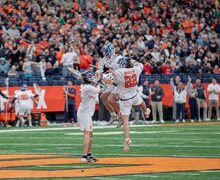La Casita’s WEIRD Barrio embraces identity through miniature art
Lars Jendruschewitz | Photo Editor
La Casita’s WEIRD Barrio exhibition features more than 30 different artworks. Each piece had a magnifying glass next to it so visitors could see every detail.
Get the latest Syracuse news delivered right to your inbox.
Subscribe to our newsletter here.
Manuel Matías created WEIRD Barrio to provide a space where people can embrace their true selves and recognize their differences as gifts. While “weird” carries a negative connotation, “barrio” deeply connects to the idea of community.
“The exhibit exemplifies a powerful way to highlight that what might be considered ‘weird’ is actually what makes a community vibrant and special,” Matías said.
WEIRD Barrio is a miniature art exhibit currently on display at Syracuse’s La Casita Cultural Center. His miniature art is made up of color-filled, highly detailed representations of landmarks where he has lived. Eight pieces inspired by Matías’ life line the walls, each accompanied by a magnifying glass. The exhibit is on display until April 2025.
When crafting the exhibit, Matías selected recognizable and familiar spaces, like central New York’s public television station WCNY. Matías said he has fallen in love with the miniature pieces because they represent what his art is at its core — a celebration of life’s fleeting moments. He said he wanted to show a sense of belonging, and longing for acceptance, in cultural meccas.
After moving from Manatí, Puerto Rico, to New York City’s Lower East Side as a child, Matías said he felt unsure of his identity. He sometimes felt too caucasian, he said, and tried to be “super Puerto Rican.”
Matías has been an artist his whole life. When he moved to central New York around 2016, he turned to miniature art forms to recreate the disappearing landscapes of his NYC home.
“Syracuse reminds me of the Lower East Side in the ‘90s, where art played a significant role in shaping the community,” Matías said. “I feel blessed to be part of a similar movement here, where art is making a real impact.”
Paola Manzano, operations assistant for WEIRD Barrio, helped install the exhibit. Both from Puerto Rico, Matías and Manzano bonded over work relating to their homeland.
“I see a lot of myself in his work, we both have very deep ties to the culture and everything surrounding it,” Manzano said.
Specific miniature creations in the exhibit are significant to Matías because they represent important moments with his family, daughters and from his childhood. Matías made his “Art is Medicine” miniature of two pills after his father was put into hospice.

Lars Jendruschewitz | Photo Editor
“Abuelita’s House” was made in a danish tin. It encapsulates the artist’s grandmother’s essence.
“Suddenly, I wanted to remember things,” Matías said. “I started creating art because I was having a hard time coping, and then it wasn’t trying to remember the past, but trying to hold on to my memories now for the future.”
Another piece that holds significance for Matías is the first full complete piece of where his daughters painted graffiti for him. Many of his pieces have his daughters’ names or graffiti marks.
“The guy that started La Casita in the Bronx mimicked houses in Puerto Rico. I created the main piece similarly because La Casita is doing so much for my family,” Matías said.
Sofia Gutierrez, an alumni of Syracuse University’s School of Architecture, has volunteered for the center as a Community Engaged Scholar for the past three years and is now a CNY Arts fellow. Gutierrez’s senior thesis project, “Futures In Public Space: El Carrito,” a real shaved ice cart, is at the exhibit until April 2025.
The cart adds a dimension of interaction to the exhibit, Gutierrez said. It gives kids something fun to do and allows parents to reminisce about their Latine childhood surrounded by family, they said. The project is very sentimental Gutierrez said and reminiscent of home and Latine gatherings.
“(The exhibit) is very much a snapshot of real life, something that we would normally see as mundane and just nothing, but in reality, everything is art,” Guiterrez said. “Everything is creation. Everything is narrative.”
Matías’ love for all the pieces in the exhibit is equal, and he said choosing a favorite piece in the exhibit would be like choosing a favorite daughter. He said “Art is Medicine” pill capsules are pretty close to his favorites.
Throughout the summer, Matías worked directly with children at La Casita and the Everson Museum of Art. In that time, they created pieces based on his work, which are on display alongside Matías’ artwork. Matías said children and adults from all around come to La Casita and immerse themselves in multiple cultures without experiencing backlash or criticism.
Matías said his experiences both in NYC and CNY have not broken him. In fact, they have made him stronger. Though his survival looks different now, he is embracing this chapter of his life.
“I’ve fallen in love with the process of creating,” Matías said. “I feel blessed to witness and be part of a similar movement here, where art is making a real impact.”
Published on October 6, 2024 at 11:53 pm






